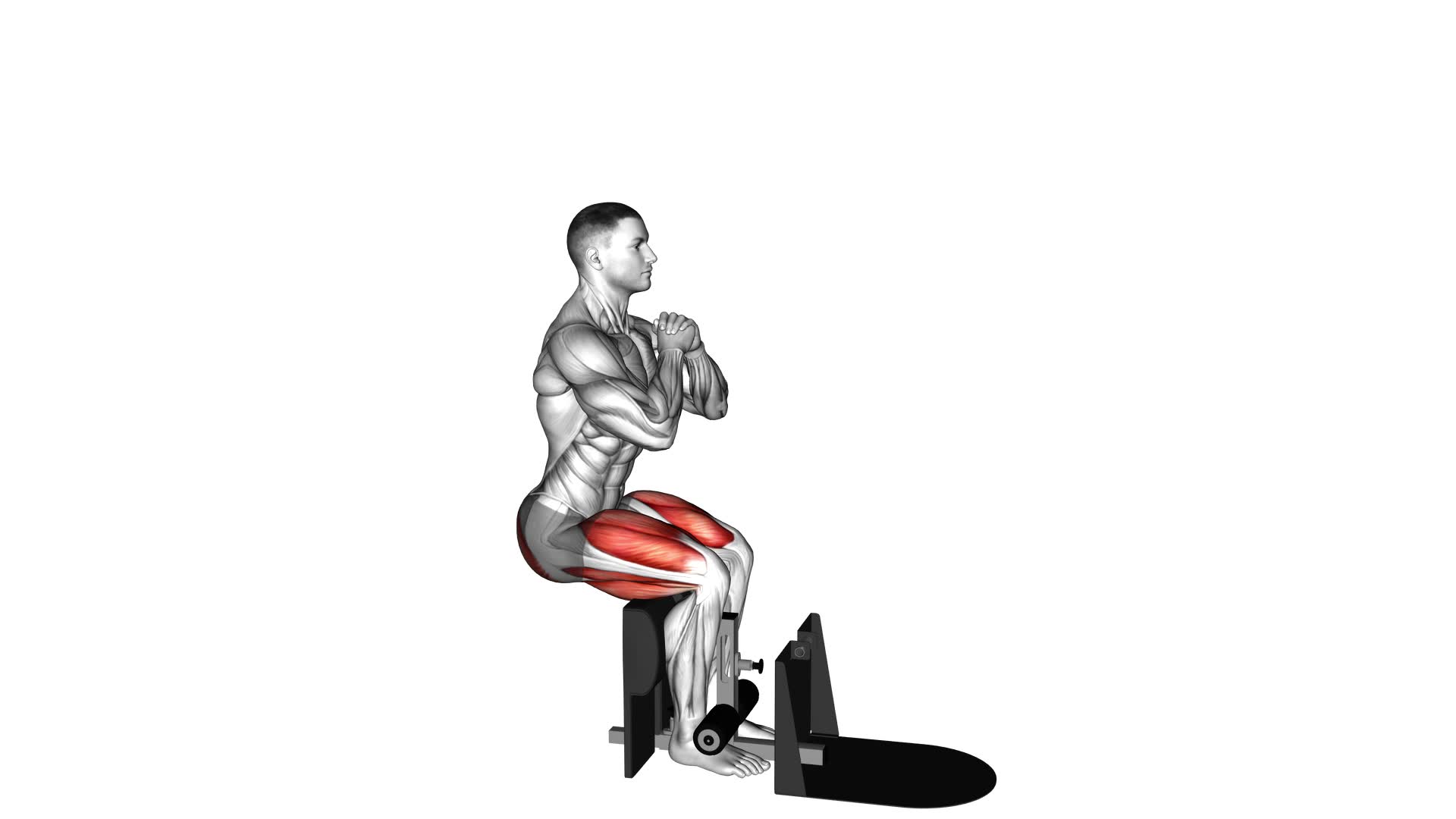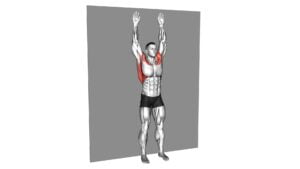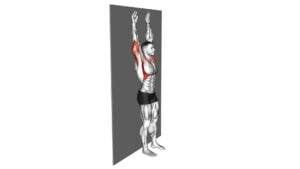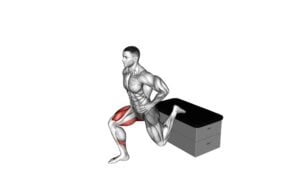Bodyweight Supported Squat (male) – Video Exercise Guide & Tips

Are you looking to improve your squat technique and build strength in your lower body? Look no further!
Watch This Exercise Video
This article will guide you through the bodyweight supported squat, a great exercise for men.
Learn the proper form, variations to challenge your muscles, and tips to avoid common mistakes.
With the help of a video exercise guide and useful tips, you'll be able to incorporate this exercise into your workout routine and see results in no time.
Key Takeaways
- Bodyweight supported squats improve lower body strength and endurance.
- They engage multiple muscle groups including quadriceps, hamstrings, glutes, and calves.
- Bodyweight supported squats are suitable for individuals of all fitness levels.
- Variations such as pistol squats, jump squats, Bulgarian split squats, and sumo squats can be used to challenge the muscles and improve overall strength.
Benefits of Bodyweight Supported Squats
One key benefit of bodyweight supported squats is that they can help you improve your lower body strength and endurance. Bodyweight squat benefits are numerous and can be enjoyed by individuals of all fitness levels. By performing bodyweight squats, you engage multiple muscle groups including your quadriceps, hamstrings, glutes, and calves. This exercise strengthens these muscles, leading to improved overall lower body strength. Additionally, bodyweight squats can enhance your endurance by increasing the capacity of your muscles to work for extended periods of time without fatigue.
To further progress in your bodyweight squat routine, you can incorporate different variations and progressions. For instance, you can try pistol squats, which involve performing squats on one leg, challenging your balance and stability. Another progression is jump squats, where you explode upwards during the squat motion, adding an element of plyometrics to your workout. By gradually incorporating these progressions into your routine, you can continue to challenge your muscles and further improve your lower body strength and endurance.
Proper Form and Technique
To perform a bodyweight supported squat with proper form and technique, you should begin by standing with your feet shoulder-width apart. Keep your back straight and engage your core muscles. As you lower your body, imagine sitting back into an imaginary chair. Bend your knees and hips simultaneously, ensuring that your knees don't extend beyond your toes. Aim to lower your body until your thighs are parallel to the ground, or as close as you can comfortably go. Pause for a moment, then push through your heels to return to the starting position.
Proper form is essential when performing bodyweight supported squats to maximize the benefits. By maintaining proper form, you engage your quadriceps, hamstrings, glutes, and core muscles effectively. This exercise helps to strengthen your lower body and improve stability and balance. Additionally, bodyweight supported squats can increase mobility in your hip and knee joints.
Now that you understand the proper form and technique of bodyweight supported squats, let's explore some variations to challenge your muscles.
Variations to Challenge Your Muscles
Ready to take your squats to the next level?
Advanced squat variations and muscle-targeting modifications can help you challenge your muscles and achieve even better results.
By incorporating these variations into your routine, you can target different muscle groups, increase intensity, and keep your workouts challenging and effective.
Advanced Squat Variations
Challenge your muscles with advanced variations of the squat. If you're looking to take your squat game to the next level, incorporating advanced squat progressions and techniques can help you achieve your goals.
One advanced variation to try is the pistol squat, where you balance on one leg while lowering your body down into a deep squat. This exercise targets your lower body muscles, particularly your quadriceps, glutes, and hamstrings.
Another challenging variation is the jump squat, which adds an explosive element to the movement by incorporating a jump at the top of the squat. This not only works your leg muscles but also improves your power and explosiveness.
Lastly, the Bulgarian split squat is a great variation that targets each leg individually, helping to correct any muscle imbalances. Remember to always maintain proper form and gradually increase the difficulty of these advanced squat variations to avoid injury and maximize results.
Muscle-Targeting Squat Modifications
To further challenge your muscles, incorporate muscle-targeting squat modifications into your workout routine. These alternative techniques can help you reap the benefits of modifications while adding variety to your workouts.
Here are three squat variations that target different muscle groups:
- Pistol Squats: This exercise targets your quadriceps, hamstrings, and glutes while also improving balance and stability. It involves performing a squat on one leg, with the other leg extended straight out in front of you.
- Sumo Squats: By taking a wider stance and turning your toes outwards, you can target your inner thighs and glutes more effectively. This variation also engages your core muscles and helps improve hip mobility.
- Bulgarian Split Squats: This modification places more emphasis on your glutes and quadriceps. By elevating one foot behind you on a bench or step, you create a deeper squat position that challenges your muscles even further.
Incorporating these muscle-targeting squat modifications into your routine can help you develop strength, improve muscle imbalances, and prevent plateaus in your fitness journey.
Common Mistakes to Avoid
To prevent injury and maximize the effectiveness of your bodyweight supported squats, make sure to avoid these common mistakes.
One common mistake isn't maintaining proper form throughout the exercise. It's important to keep your back straight and chest lifted, avoiding rounding your shoulders or hunching forward.
Another mistake isn't going low enough in your squat. Make sure to lower your body until your thighs are parallel to the ground, or even lower if you can. This will engage your muscles more effectively and increase the difficulty of the exercise.
Additionally, rushing through the squat can lead to poor form and potential injury. Take your time and focus on the movement, ensuring that you're performing each repetition with control and precision.
Lastly, neglecting to warm up before attempting bodyweight supported squats can increase the risk of injury. It's important to properly warm up your muscles and joints to prepare them for the exercise.
Tips for Increasing Difficulty
To increase the difficulty of the bodyweight supported squat, there are a few tips you can follow.
First, you can add resistance bands to provide extra resistance as you squat.
Another option is to try elevated surface variations, such as squatting on a step or platform.
Lastly, you can progress to single leg squats to challenge your balance and strength even further.
Incorporating these tips will help you take your bodyweight supported squats to the next level.
Adding Resistance Bands
Increase the difficulty of the bodyweight supported squat exercise by incorporating resistance bands into your routine. Resistance bands are a versatile tool that can add an extra challenge to your workout.
Here are three tips for incorporating resistance bands into your bodyweight supported squat exercise:
- Attach the resistance band to an anchor point, such as a sturdy pole or door frame, and loop it around your hips. This will create resistance as you lower into the squat and make the exercise more challenging.
- Use a thicker resistance band to increase the difficulty. Thicker bands provide more resistance, requiring your muscles to work harder.
- Gradually increase the tension of the resistance band over time. As you get stronger, you can add more resistance to continue challenging your muscles.
Elevated Surface Variations
Challenge yourself by incorporating elevated surface variations into your bodyweight supported squat exercise.
Elevating your feet or using an elevated surface like a step or a platform can provide several benefits to your workout.
Firstly, it increases the range of motion, allowing for a deeper squat and engaging more muscle fibers. This helps to strengthen your lower body and improve your overall stability and balance.
Secondly, it adds an element of instability, requiring your muscles to work harder to maintain proper form. This helps to enhance your core strength and coordination.
Lastly, elevated surface variations are considered advanced squat techniques, making them a great option for those looking to challenge themselves and take their squat workout to the next level.
Single Leg Progression
By incorporating single leg progression into your bodyweight supported squat exercise, you can further intensify your workout and target specific muscles for increased strength and stability.
Here are some progression techniques to help you challenge yourself and prevent injuries:
- Single Leg Squat: Stand on one leg and lower your body down as far as you can while keeping your balance. This exercise activates your core and challenges your stability.
- Pistol Squat: Extend one leg out in front of you and squat down on the other leg until your thigh is parallel to the ground. This advanced progression requires strength and flexibility.
- Bulgarian Split Squat: Place one foot behind you on an elevated surface and lower your body down into a lunge position. This exercise targets your glutes and quadriceps.
By incorporating these progression techniques, you can continue to challenge your muscles and prevent injuries.
Now let's explore how to incorporate bodyweight supported squats into your workout routine.
Incorporating Bodyweight Supported Squats Into Your Workout Routine
Start incorporating bodyweight supported squats into your workout routine to enhance your lower body strength and stability. Bodyweight supported squats offer several benefits that can help you achieve your fitness goals.
First, they allow you to safely perform squats, even if you have limited mobility or joint pain. The support provided by the machine helps alleviate pressure on the knees and lower back, reducing the risk of injury.
Additionally, bodyweight supported squats target multiple muscle groups, including the quadriceps, hamstrings, glutes, and calves, helping you build overall lower body strength.
To increase the difficulty of bodyweight supported squats, you can try a few tips. First, you can gradually decrease the amount of support provided by the machine by adjusting the resistance or using a lighter weight. This will force your muscles to work harder to stabilize your body during the exercise.
Another option is to slow down the movement and focus on maintaining proper form throughout the squat. This will increase the time under tension, maximizing the effectiveness of the exercise.
Finally, you can incorporate variations such as single-leg squats or jump squats to further challenge your muscles. Remember to always listen to your body and progress at a pace that feels comfortable for you.
Frequently Asked Questions
How Many Repetitions Should I Aim for When Doing Bodyweight Supported Squats?
When doing bodyweight supported squats, you should aim for a specific number of repetitions based on your fitness level and goals. The number of repetitions can vary, but a general guideline is to start with 8-12 reps per set. Gradually increase the number of repetitions as you get stronger.
Bodyweight supported squats have numerous benefits, including improving lower body strength, stability, and balance. They're also a great exercise for beginners or those recovering from injury.
Can Bodyweight Supported Squats Help Me Build Muscle in My Upper Body?
Yes, bodyweight supported squats can help build muscle in your upper body! While they primarily target the lower body, they also engage the muscles in your arms, shoulders, and back. By supporting your bodyweight, these squats provide a challenging workout that can lead to muscle growth and strength development in both your lower and upper body.
Additionally, bodyweight supported squats are great for weight loss and overall fitness.
Is It Necessary to Warm up Before Doing Bodyweight Supported Squats?
Before doing bodyweight supported squats, it's important for you to warm up. Warming up helps prepare your muscles and joints for the exercise, reducing the risk of injury. It also increases blood flow and body temperature, which improves your overall performance.
Neglecting to warm up can lead to muscle strains and other injuries. Additionally, make sure to avoid common mistakes such as leaning too far forward or letting your knees cave in.
Can Bodyweight Supported Squats Be Modified for Individuals With Knee or Back Injuries?
Yes, bodyweight supported squats can be modified for individuals with knee or back injuries. By using a support or a chair, you can reduce the pressure on your knees and back while still benefiting from the exercise.
These modifications allow you to strengthen your muscles and improve your range of motion without causing further injury.
Bodyweight supported squats are particularly beneficial for rehabilitation as they help to build strength and stability in the lower body while minimizing strain on the injured areas.
Are Bodyweight Supported Squats Suitable for Beginners or Should They Be Done by More Experienced Individuals?
Bodyweight supported squats can be a great exercise for beginners. They provide support and help build strength in your lower body without putting too much strain on your knees or back.
However, they can also benefit more experienced individuals by allowing them to focus on proper form and really target their leg muscles.
Beginners can modify the exercise by using a higher support or starting with smaller ranges of motion until they feel comfortable.
Conclusion
In conclusion, bodyweight supported squats are a great exercise for building strength and targeting your leg muscles. By maintaining proper form and technique, you can maximize the benefits of this exercise.
Additionally, incorporating variations and avoiding common mistakes will help challenge your muscles and prevent injury. With these tips in mind, you can easily incorporate bodyweight supported squats into your workout routine and achieve your fitness goals.

Author
Years ago, the spark of my life’s passion ignited in my mind the moment I stepped into the local gym for the first time. The inaugural bead of perspiration, the initial endeavor, the very first surge of endorphins, and a sense of pride that washed over me post-workout marked the beginning of my deep-seated interest in strength sports, fitness, and sports nutrition. This very curiosity blossomed rapidly into a profound fascination, propelling me to earn a Master’s degree in Physical Education from the Academy of Physical Education in Krakow, followed by a Sports Manager diploma from the Jagiellonian University. My journey of growth led me to gain more specialized qualifications, such as being a certified personal trainer with a focus on sports dietetics, a lifeguard, and an instructor for wellness and corrective gymnastics. Theoretical knowledge paired seamlessly with practical experience, reinforcing my belief that the transformation of individuals under my guidance was also a reflection of my personal growth. This belief holds true even today. Each day, I strive to push the boundaries and explore new realms. These realms gently elevate me to greater heights. The unique combination of passion for my field and the continuous quest for growth fuels my drive to break new ground.







